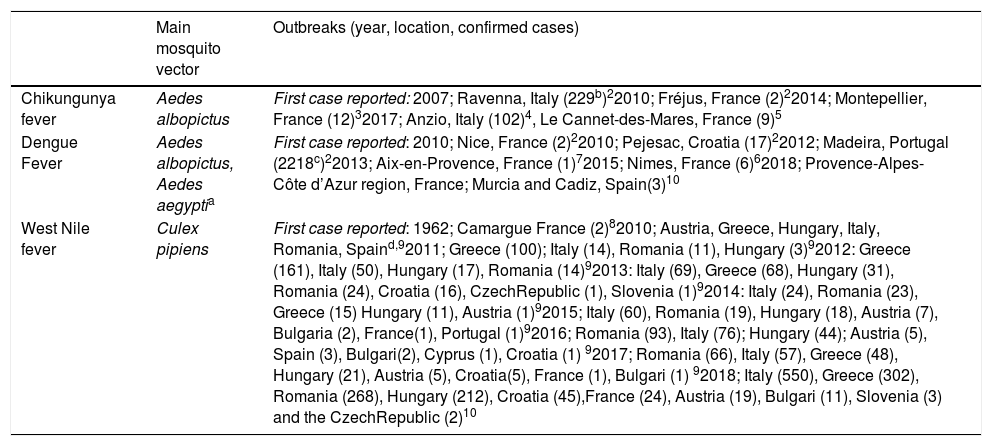Increasing globalization in travel and trade, together with global expansion and the establishment of competent vectors, has enabled the introduction into European Union countries of arboviruses that are widely circulating in tropical areas. Furthermore, several European countries have a close link to highly endemic areas for arboviruses: France has important overseas colonies (Americas, Africa and Oceania), or Portuguese island of Madeira, that has strong social and commercial relations with Brazil. Many European countries, including Spain, receive a huge number of immigrants and travellers from Latin America every year. In that sense, viremic international travel returning from epidemic regions to an area where a competent vector is established can trigger outbreaks, as has happened previously.
Global warming has allowed mosquitoes, such as Aedes o Culex, to proliferate, adapt to environmental conditions, migrate and spread to new niche areas in Europe that have become warmer.1 This fact can contribute both to an increased risk of outbreaks of vector-borne diseases in Europe, such as the Dengue or Chikungunya viruses, and to open the door to new arbovirus infections, such as Zika, Ross River, or Mayaro.
Every year more than 200 seasonal cases of West Nile virus are reported, and sporadic and self-limited outbreaks of Dengue (including the recent report of autochthonous cases in Spain) and Chikungunya viral infection. We conducted an electronic literature search through PubMed (keywords used: [Chikungunya] OR [dengue] or [zika] or [west Nile] or [arboviral infection] AND [European autochthonous cases]) restricted to humans, and also consulted data extracted from the European Centre for Disease Prevention and Control (ECDC), focusing on the most recent outbreaks arboviral infections in non-tropical European Union territories from 2010 to November 2018 (Table 1).
Outbreaks of mosquito-borne viral infections in non-tropical European Union territories (2010–2018).
| Main mosquito vector | Outbreaks (year, location, confirmed cases) | |
|---|---|---|
| Chikungunya fever | Aedes albopictus | First case reported: 2007; Ravenna, Italy (229b)22010; Fréjus, France (2)22014; Montepellier, France (12)32017; Anzio, Italy (102)4, Le Cannet-des-Mares, France (9)5 |
| Dengue Fever | Aedes albopictus, Aedes aegyptia | First case reported: 2010; Nice, France (2)22010; Pejesac, Croatia (17)22012; Madeira, Portugal (2218c)22013; Aix-en-Provence, France (1)72015; Nimes, France (6)62018; Provence-Alpes-Côte d’Azur region, France; Murcia and Cadiz, Spain(3)10 |
| West Nile fever | Culex pipiens | First case reported: 1962; Camargue France (2)82010; Austria, Greece, Hungary, Italy, Romania, Spaind,92011; Greece (100); Italy (14), Romania (11), Hungary (3)92012: Greece (161), Italy (50), Hungary (17), Romania (14)92013: Italy (69), Greece (68), Hungary (31), Romania (24), Croatia (16), CzechRepublic (1), Slovenia (1)92014: Italy (24), Romania (23), Greece (15) Hungary (11), Austria (1)92015; Italy (60), Romania (19), Hungary (18), Austria (7), Bulgaria (2), France(1), Portugal (1)92016; Romania (93), Italy (76); Hungary (44); Austria (5), Spain (3), Bulgari(2), Cyprus (1), Croatia (1) 92017; Romania (66), Italy (57), Greece (48), Hungary (21), Austria (5), Croatia(5), France (1), Bulgari (1) 92018; Italy (550), Greece (302), Romania (268), Hungary (212), Croatia (45),France (24), Austria (19), Bulgari (11), Slovenia (3) and the CzechRepublic (2)10 |
The presence of a competent vector, optimal climatic conditions and the possibility of returning patients who are viremic are prerequisites for autochthonous transmission of arboviruses, are currently being met in many countries in Europe. Health professionals should be trained to identify arboviral diseases symptoms and to introduce them into the differential diagnosis, not only among patients returning from the tropics, but also in local patients from countries and areas with the presence of suitable vectors, so that possible outbreaks can be identified before they can have major consequences. Epidemiological and entomological surveillance is necessary to detect and control further outbreaks and to minimize the risk of local transmission in vector-colonized areas.
FundingsThis work was supported by the Network of Tropical Diseases Research RICET (RD16/0027/0002) and FEDER.
Competing interestsNone.







